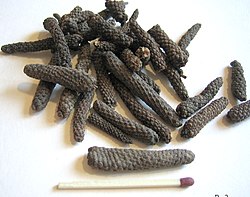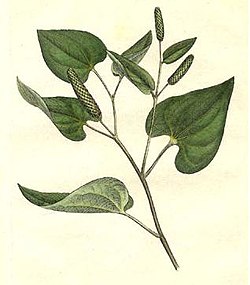Note: This is a project under development. The articles on this wiki are just being initiated and broadly incomplete. You can Help creating new pages.
Piper longum - Pippali
Long pepper is a flowering vine in the family Piperaceae. and cultivated for its fruit, which is usually dried and used as a spice and seasoning. Long pepper has a taste similar to, but hotter than that of its close relative Piper nigrum - from which black, green and white pepper are obtained.
Uses
Headache, Toothache, Asthma, Bronchitis, Cholera, Coma, Cough, Diarrhea, Epilepsy, Fever, Stomachache, Stroke, Indigestion, Respiratory disorder, Pain abdomen, Worms, Hoarseness of voice.
Parts Used
Chemical Composition
Coumaperine, methoxyphenyl, pentenoyl piperidine, piperolactam A, methylenedioxyphenyl, pentadienyl pirrolidine, methylenedioxyphenyl, pentenyl, pirrolidine, methylene dioxyphenyl, nonadienyl, pyrrolidine [1]
Common names
| Language | Common name |
|---|---|
| Kannada | Hippali, Kandan Lippili |
| Hindi | Pipli |
| Malayalam | Tippali |
| Tamil | Tippili |
| Telugu | Pippallu |
| Marathi | NA |
| Gujarathi | NA |
| Punjabi | NA |
| Kashmiri | NA |
| Sanskrit | Pippali, Magadhi |
| English | Long Pepper, Indian long pepper |
Properties
Reference: Dravya - Substance, Rasa - Taste, Guna - Qualities, Veerya - Potency, Vipaka - Post-digesion effect, Karma - Pharmacological activity, Prabhava - Therepeutics.
Dravya
Rasa
Katu (Pungent)
Guna
Laghu (Light), Tikshna (Sharp)
Veerya
Sheeta (Cold)
Vipaka
Madhura (Sweet)
Karma
Kapha, Vata
Prabhava
Habit
Identification
Leaf
| Kind | Shape | Feature |
|---|---|---|
| Simple | Ovate-cordate | Leaves are 6.3 to 9.0 cm, cordate, broadly ovate or oblong-oval, dark green and shining above, margin entire, 7 nerves arise from the base, nerves impressed; petiole 1-3 cm long. |
Flower
| Type | Size | Color and composition | Stamen | More information |
|---|---|---|---|---|
| Unisexual | 1 to 3 inch long | Yellow | 5-20 | Flowers are monoceous and male and female flowers are borne on different plants |
Fruit
| Type | Size | Mass | Appearance | Seeds | More information |
|---|---|---|---|---|---|
| Fleshy | 7–10 mm | fruit is ripes it attains red color and when it dries it attains black color | many | {{{6}}} |
Other features
List of Ayurvedic medicine in which the herb is used
Where to get the saplings
Mode of Propagation
How to plant/cultivate
Long pepper is propagated through stem/vine cuttings at the beginning of rainy season. However, it can be easily propagated through the terminal stem cuttings obtained from one year old growth and 3-5 internodes.[4]
Commonly seen growing in areas
Photo Gallery
References
External Links
- Ayurvedic Herbs known to be helpful to treat Headache
- Ayurvedic Herbs known to be helpful to treat Toothache
- Ayurvedic Herbs known to be helpful to treat Asthma
- Ayurvedic Herbs known to be helpful to treat Bronchitis
- Ayurvedic Herbs known to be helpful to treat Cholera
- Ayurvedic Herbs known to be helpful to treat Coma
- Ayurvedic Herbs known to be helpful to treat Cough
- Ayurvedic Herbs known to be helpful to treat Diarrhea
- Ayurvedic Herbs known to be helpful to treat Epilepsy
- Ayurvedic Herbs known to be helpful to treat Fever
- Ayurvedic Herbs known to be helpful to treat Stomachache
- Ayurvedic Herbs known to be helpful to treat Stroke
- Ayurvedic Herbs known to be helpful to treat Indigestion
- Ayurvedic Herbs known to be helpful to treat Respiratory disorder
- Ayurvedic Herbs known to be helpful to treat Pain abdomen
- Ayurvedic Herbs known to be helpful to treat Worms
- Ayurvedic Herbs known to be helpful to treat Hoarseness of voice
- Herbs with Roots used in medicine
- Herbs with Dried spikes used in medicine
- Herbs with common name in Kannada
- Herbs with common name in Hindi
- Herbs with common name in Malayalam
- Herbs with common name in Tamil
- Herbs with common name in Telugu
- Herbs with common name in Sanskrit
- Herbs with common name in English
- Habit - Herb
- Index of Plants which can be propagated by Seeds
- Index of Plants which can be propagated by Cuttings
- Herbs that are commonly seen in the region of Tall grasslands
- Herbs that are commonly seen in the region of At meadows
- Herbs that are commonly seen in the region of Borders of forests and fields
- Herbs
- Piperaceae



